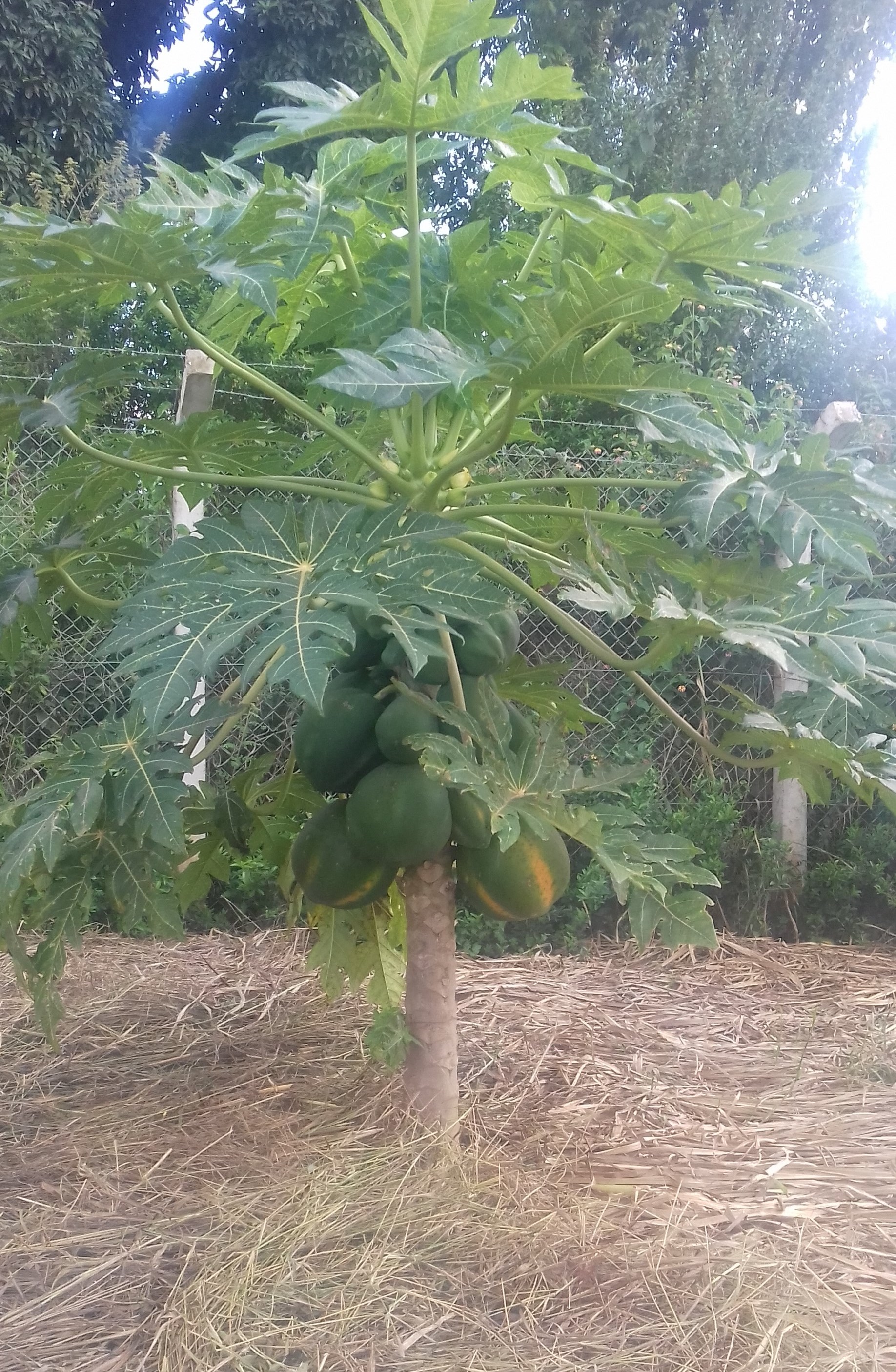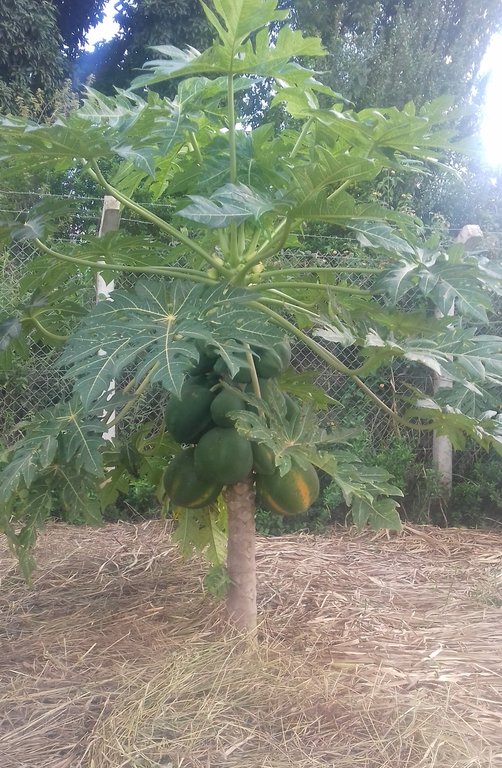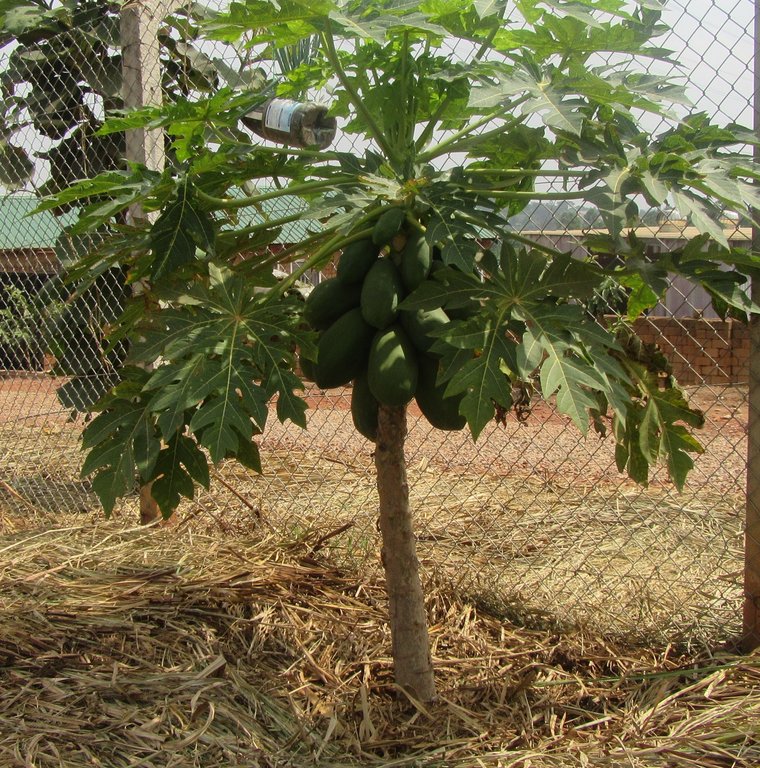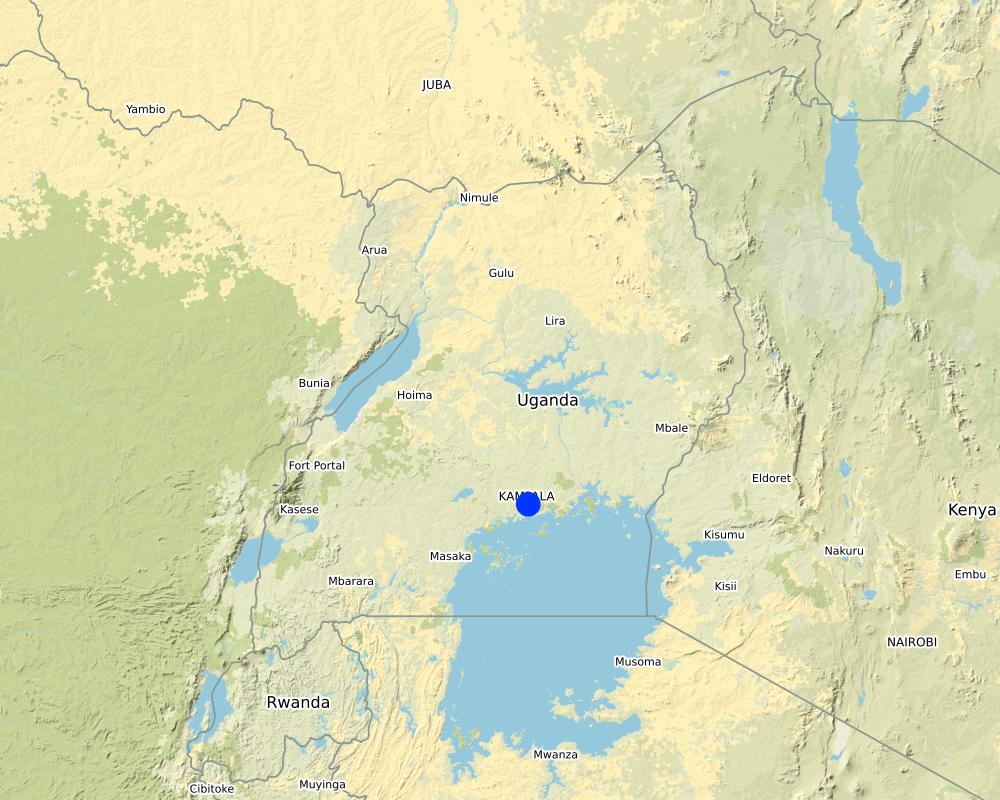Intensification of pawpaw with mulching [乌干达]
- 创建:
- 更新:
- 编制者: Babirye Irene
- 编辑者: Kamugisha Rick Nelson
- 审查者: Nicole Harari, Udo Höggel, Donia Mühlematter
Okulima amapapali
technologies_3461 - 乌干达
查看章节
全部展开 全部收起1. 一般信息
1.2 参与该技术评估和文件编制的资源人员和机构的联系方式
关键资源人
土地使用者:
Kasasila Medad
+256702776511
NARO
Ttakajjunge Village, Namubiru Parish, Nama Sub-county Mukono District.
乌干达
有助于对技术进行记录/评估的项目名称(如相关)
Scaling-up SLM practices by smallholder farmers (IFAD)有助于对技术进行记录/评估的机构名称(如相关)
National Agricultural Research Organisation (NARO) - 乌干达1.3 关于使用通过WOCAT记录的数据的条件
(现场)数据是什么时候汇编的?:
01/02/2018
编制者和关键资源人员接受有关使用通过WOCAT记录数据的条件。:
是
1.4 所述技术的可持续性声明
这里所描述的技术在土地退化方面是否存在问题,导致无法被认为是一种可持续的土地管理技术?:
否
2. SLM技术的说明
2.1 技术简介
技术定义:
Improved pawpaw (Carica papaya) fruit tree growing using improved varieties for Sustainable Land Management Practices and income generation.
2.2 技术的详细说明
说明:
Intensification of pawpaw with mulching. It is the growing of improved pawpaw fruit tree growing for sustainable land management practices and income generation among small scale and medium farmers in Kampala. This is established on 1.5 acres of land. The technology is mostly prefered because it doesn’t require much attention or specialized planting (labour). The cultivation is pest-resistant, and thrives in well-drained soil with an equal balance of sunshine and shade as well as reduction of soil degradation. Under this technology, pawpaws are integrated with trenches with the aim of reducing soil and water erosion for increased production and soil fertility improvement. In Uganda, specifically Kampala District, the technology started in 2012 where the host farmer visited a friend in the neighbouring village, who was growing pawpaw on a commercial scale, and acquired knowledge and skills, inputs and resources needed for establishment.
To get the pawpaw seeds, I got a ripe pawpaw from which I extracted healthy seeds, which I used to make a nursery bed. The pawpaw seeds I got were of the big pawpaw with yellow flesh. I chose this variety because it has a longer shelf life compared to the red flesh variety. In addition, its fruits are big and tasty. and then I dried them in the sun. Got two Units of loam / sandy soil mixed with one basin of cow dung to improve on its drainage and fertility, filled the bags with a mixture of sandy loam manured soil, sown 1 or 2 seeds in each bag and covered with soil, then watered the beds once every day, morning or evening. (description of farmer)
The farmer also covered the bags with thatch grass to keep them warm and moist still they emerge. After one month when the seedlings had germinated he sprayed them with Vegimax, which is an Organic Supplement for all types of plants that helps improve the quality, yield, appearance as well as soil condition and later applied 'Dudu cyper' (insecticide) to kill insects that attack the leaves. When the seedlings were about 10-15 cm tall, they were transplanted onto a well prepared field. A slit was cut into the plastic bag down one side to remove the bag and place the plant into the planting pit. Spacing of plants was approximately 3 metres between rows and 3 metres between plants. Soil was raked in to cover the roots. The plants were then watered to provide moisture needed for proper rooting and growth.
Activities carried out in this technology include: Nursery bed preparation, watering once a day, garden preparation, digging of planting pits, mixing animal manure with soil, transplanting from the nursery bed to the main garden, mulching the garden using banana leaves and grass, spraying the plantations,pruning and harvesting. Proper spacing of trees is important because if they are not well spaced, they will just grow tall and fruiting will be poor. I started with one acre of pawpaw where I had initially 250 pawpaw trees but a density of up to 440 trees is possible.
The technology is good at income generating. Having one acre of the improved pawpaw the farmer can pick five to seven pawpaws every week from each tree and harvest throughout the year so every time the farmer has something to sell to the market. However Paw paws are easily perishable and this affects the market in addition to being affected by weather changes especially when it rains a lot the demand for the fruit becomes very low and when it’s the long dry spells also affect the plantations since the farmer cannot afford to irrigate through the dry season. During long dry periods, pawpaw doesn’t perform well so the harvest is low. Strong wind can cause problems to pawpaw plantations because pawpaw plants have a shallow root system, they get very top heavy as they grow older, and they blow over easily. Then there are birds and fruit bats which affect the plantation. In case of such scenarios its advisable that the farmer keeps in touch with extension worker for advisory services and all the necessary management advice (pest management, watering and marketing).
2.3 技术照片
关于照片的一般说明:
At the moment i cannot have the preparation and management of the technology since by the time I documented it, the farmer was harvesting.
2.4 技术视频
注释、简短说明:
Pawpaw growing with mulching on a small scale.
日期:
01/03/2018
位置:
Ttakajjunge village, Namubiru Parish, Nama subcounty, Mukono District.
摄影师的名字:
Irene Babirye
2.5 已应用该技术的、本评估所涵盖的国家/地区/地点
国家:
乌干达
区域/州/省:
Mukono District, Central Region
有关地点的进一步说明:
Ttakajjunge village, Namubiru parish, Nama Village Mukono District.
注释:
N00.23372, e032.59098
Map
×2.6 实施日期
注明实施年份:
2016
如果不知道确切的年份,请说明大概的日期:
- 不到10年前(最近)
2.7 技术介绍
详细说明该技术是如何引入的:
- 通过土地使用者的创新
- 在实验/研究期间
注释(项目类型等):
From my neighbor.
3. SLM技术的分类
3.1 该技术的主要目的
- 改良生产
- 减少、预防、恢复土地退化
- 保持/提高生物多样性
- 降低灾害风险
- 创造有益的经济影响
- 创造有益的社会影响
3.2 应用该技术的当前土地利用类型

农田
- 多年一作(非木材)
主要农作物(经济作物及粮食作物):
pawpaw

森林/林地
植树造林:
- 单一栽培的外来品种
产品和服务:
- 水果和坚果
3.3 有关土地利用的更多信息
该技术所应用土地的供水:
- 雨养
每年的生长季节数:
- 2
具体说明:
Main harvest in May and December.
3.4 该技术所属的SLM组
- 改良的地面/植被覆盖
- 最小的土壤扰动
- 土壤肥力综合管理
3.5 技术传播
具体说明该技术的分布:
- 均匀地分布在一个区域
如果该技术均匀地分布在一个区域上,请注明覆盖的大致区域。:
- < 0.1 平方千米(10 公顷)
注释:
The technology is applied on a 1.5 acre plot
3.6 包含该技术的可持续土地管理措施

农艺措施
- A1:植被和土壤覆盖层
- A2:有机质/土壤肥力
- A5:种子管理,改良品种

植物措施
- V2:草和多年生草本植物

结构措施
- S1:阶地

管理措施
- M4:活动时间安排的重大变化
3.7 该技术强调的主要土地退化类型

土壤风蚀

生物性退化
- Bl:土壤寿命损失
注释:
This technology is not done primarily to reduce land degradation. This is rather a side effect.
3.8 防止、减少或恢复土地退化
具体数量名该技术与土地退化有关的目标:
- 不适用
注释:
This technology is not done primarily to reduce land degradation. This is rather a side effect.
4. 技术规范、实施活动、投入和成本
4.1 该技术的技术图纸
4.2 技术规范/技术图纸说明
The technical drawing shows pawpaw trees planted at a spacing of 3 m x 3 m from one pawpaw to another pawpaw tree. The planting hole is 30 cm deep.
Slope: Gentle sloping
4.3 有关投入和成本计算的一般信息
具体说明成本和投入是如何计算的:
- 每个技术区域
注明尺寸和面积单位:
1.5 acre
具体说明成本计算所用货币:
- 美元
注明美元与当地货币的汇率(如相关):1美元=:
3600.0
注明雇用劳工的每日平均工资成本:
2.8
4.4 技术建立活动
| 活动 | 措施类型 | 时间 | |
|---|---|---|---|
| 1. | Nursery Preparation | 农业学的 | 2 days |
| 2. | Watering | 管理 | everyday |
| 3. | Garden preparation | 农业学的 | 7 days |
| 4. | Digging pits | 农业学的 | 4 days |
| 5. | Compost and soil mixing | 农业学的 | 2 days |
| 6. | Transplanting | 农业学的 | 5 days |
| 7. | Mulching | 农业学的 | 2 days |
| 8. | Spraying | 农业学的 | 1 day |
4.5 技术建立所需要的费用和投入
| 对投入进行具体说明 | 单位 | 数量 | 单位成本 | 每项投入的总成本 | 土地使用者承担的成本% | |
|---|---|---|---|---|---|---|
| 劳动力 | Nursery Preparation | Man days | 2.0 | 2.8 | 5.6 | 100.0 |
| 劳动力 | Watering | Man days | 1.0 | 1.39 | 1.39 | 100.0 |
| 劳动力 | Garden preparation | Man days | 4.0 | 2.8 | 11.2 | 100.0 |
| 劳动力 | Digging pits | Man days | 4.0 | 2.8 | 11.2 | 100.0 |
| 设备 | Animal manure and soil mixing | Man days | 2.0 | 1.39 | 2.78 | 100.0 |
| 设备 | Transplanting | Man days | 5.0 | 2.8 | 14.0 | 100.0 |
| 设备 | Mulching the garden | Man days | 5.0 | 2.8 | 14.0 | 100.0 |
| 设备 | Spraying | Man days | 1.0 | 2.8 | 2.8 | 100.0 |
| 设备 | Hoes | Pieces | 5.0 | 2.8 | 14.0 | 100.0 |
| 设备 | Wheelbarrows | Pieces | 3.0 | 33.4 | 100.2 | 100.0 |
| 设备 | Gumboots | Pairs | 5.0 | 3.4 | 17.0 | 100.0 |
| 设备 | Sprayer pump | Piece | 1.0 | 13.9 | 13.9 | 100.0 |
| 植物材料 | Watering cans | Pieces | 3.0 | 2.8 | 8.4 | 100.0 |
| 植物材料 | Seeds | Kilograms | 5.0 | 1.39 | 6.95 | 100.0 |
| 肥料和杀菌剂 | Vegimax, | Litres | 5.0 | 3.4 | 17.0 | 100.0 |
| 肥料和杀菌剂 | Dudu cyper | Litres | 3.0 | 2.8 | 8.4 | 100.0 |
| 肥料和杀菌剂 | Dythene | Kilograms | 3.0 | 6.94 | 20.82 | 100.0 |
| 肥料和杀菌剂 | Animal manure | Trip | 1.0 | 11.2 | 11.2 | 100.0 |
| 技术建立所需总成本 | 280.84 | |||||
注释:
The land user had ready capital to establish the technology.
4.6 维护/经常性活动
| 活动 | 措施类型 | 时间/频率 | |
|---|---|---|---|
| 1. | Spraying | 农业学的 | Every after 3 weeks |
| 2. | Prunning | 农业学的 | Every week |
| 3. | Digging | 农业学的 | Every month |
| 4. | Mulching | 农业学的 | Every after 6 months |
| 5. | Animal manure application to the garden | 农业学的 | Every after a year |
4.7 维护/经常性活动所需要的费用和投入(每年)
| 对投入进行具体说明 | 单位 | 数量 | 单位成本 | 每项投入的总成本 | 土地使用者承担的成本% | |
|---|---|---|---|---|---|---|
| 劳动力 | Spraying | Man day | 1.0 | 2.8 | 2.8 | 100.0 |
| 劳动力 | Prunning | Man day | 2.0 | 2.8 | 5.6 | 100.0 |
| 劳动力 | Mulching | Man day | 3.0 | 2.8 | 8.4 | 100.0 |
| 劳动力 | Animal manure application to the garden | Man day | 2.0 | 2.8 | 5.6 | 100.0 |
| 设备 | Harvesting | Man day | 2.0 | 2.8 | 5.6 | 100.0 |
| 设备 | Hoes | Pieces | 5.0 | 2.8 | 14.0 | 100.0 |
| 设备 | Sprayer pump | Piece | 1.0 | 2.8 | 2.8 | 100.0 |
| 设备 | 1.0 | 13.9 | 13.9 | 100.0 | ||
| 肥料和杀菌剂 | Vegimax | Litres | 5.0 | 3.4 | 17.0 | 100.0 |
| 肥料和杀菌剂 | Dudu cyper | Litres | 3.0 | 2.8 | 8.4 | 100.0 |
| 肥料和杀菌剂 | Dythene | Litres | 5.0 | 6.94 | 34.7 | 100.0 |
| 肥料和杀菌剂 | Animal manure | Trip | 1.0 | 11.2 | 11.2 | 100.0 |
| 技术维护所需总成本 | 130.0 | |||||
注释:
The land user incurs all the costs.
4.8 影响成本的最重要因素
描述影响成本的最决定性因素:
Labor costs are those cost which most heavily affect the technology.
5. 自然和人文环境
5.1 气候
年降雨量
- < 250毫米
- 251-500毫米
- 501-750毫米
- 751-1,000毫米
- 1,001-1,500毫米
- 1,501-2,000毫米
- 2,001-3,000毫米
- 3,001-4,000毫米
- > 4,000毫米
指定年平均降雨量(若已知),单位为mm:
1500.00
农业气候带
- 潮湿的
5.2 地形
平均坡度:
- 水平(0-2%)
- 缓降(3-5%)
- 平缓(6-10%)
- 滚坡(11-15%)
- 崎岖(16-30%)
- 陡峭(31-60%)
- 非常陡峭(>60%)
地形:
- 高原/平原
- 山脊
- 山坡
- 山地斜坡
- 麓坡
- 谷底
垂直分布带:
- 0-100 m a.s.l.
- 101-500 m a.s.l.
- 501-1,000 m a.s.l.
- 1,001-1,500 m a.s.l.
- 1,501-2,000 m a.s.l.
- 2,001-2,500 m a.s.l.
- 2,501-3,000 m a.s.l.
- 3,001-4,000 m a.s.l.
- > 4,000 m a.s.l.
说明该技术是否专门应用于:
- 不相关
5.3 土壤
平均土层深度:
- 非常浅(0-20厘米)
- 浅(21-50厘米)
- 中等深度(51-80厘米)
- 深(81-120厘米)
- 非常深(> 120厘米)
土壤质地(表土):
- 中粒(壤土、粉土)
土壤质地(地表以下> 20厘米):
- 中粒(壤土、粉土)
表土有机质:
- 中(1-3%)
5.4 水资源可用性和质量
地下水位表:
5-50米
地表水的可用性:
好
水质(未处理):
良好饮用水
水的盐度有问题吗?:
否
该区域正在发生洪水吗?:
否
5.5 生物多样性
物种多样性:
- 低
栖息地多样性:
- 低
5.6 应用该技术的土地使用者的特征
定栖或游牧:
- 定栖的
生产系统的市场定位:
- 混合(生计/商业
- 商业/市场
非农收入:
- 低于全部收入的10%
相对财富水平:
- 平均水平
个人或集体:
- 个人/家庭
机械化水平:
- 手工作业
性别:
- 男人
土地使用者的年龄:
- 青年人
- 中年人
说明土地使用者的其他有关特征:
The land user is married with six children, is a commercial pawpaw farmer, is business oriented and a primary four school drop out.
5.7 应用该技术的土地使用者拥有或租用的平均土地面积
- < 0.5 公顷
- 0.5-1 公顷
- 1-2 公顷
- 2-5公顷
- 5-15公顷
- 15-50公顷
- 50-100公顷
- 100-500公顷
- 500-1,000公顷
- 1,000-10,000公顷
- > 10,000公顷
这被认为是小规模、中规模还是大规模的(参照当地实际情况)?:
- 中等规模的
5.8 土地所有权、土地使用权和水使用权
土地所有权:
- 个人,有命名
土地使用权:
- 个人
用水权:
- 个人
注释:
The land user inherented the land from the grandfather.
5.9 进入服务和基础设施的通道
健康:
- 贫瘠
- 适度的
- 好
教育:
- 贫瘠
- 适度的
- 好
技术援助:
- 贫瘠
- 适度的
- 好
就业(例如非农):
- 贫瘠
- 适度的
- 好
市场:
- 贫瘠
- 适度的
- 好
能源:
- 贫瘠
- 适度的
- 好
道路和交通:
- 贫瘠
- 适度的
- 好
饮用水和卫生设施:
- 贫瘠
- 适度的
- 好
金融服务:
- 贫瘠
- 适度的
- 好
6. 影响和结论性说明
6.1 该技术的现场影响
社会经济效应
收入和成本
农业收入
注释/具体说明:
The income of the farmer increased after the establishment of the technology.
社会文化影响
国家机构
注释/具体说明:
Many institutions like NARO have done research which helped in developing the technology.
SLM/土地退化知识
注释/具体说明:
We use trenches in the pawpaw garden.
生态影响
土壤
土壤覆盖层
注释/具体说明:
Mulching prevents direct sun on the soil.
6.2 该技术的场外影响已经显现
下游淤积
对邻近农田的破坏
注释/具体说明:
The technology is mulched which prevents soil erosion to the neighbor's fields.
6.3 技术对渐变气候以及与气候相关的极端情况/灾害的暴露和敏感性(土地使用者认为的极端情况/灾害)
渐变气候
渐变气候
| 季节 | 气候变化/极端天气的类型 | 该技术是如何应对的? | |
|---|---|---|---|
| 季雨量 | 旱季 | 增加 | 适度 |
气候有关的极端情况(灾害)
气候灾害
| 该技术是如何应对的? | |
|---|---|
| 干旱 | 适度 |
生物灾害
| 该技术是如何应对的? | |
|---|---|
| 昆虫/蠕虫侵扰 | 适度 |
注释:
Since the technology is mulched the dry season doesn't affect PawPaw plantations much .
6.4 成本效益分析
技术收益与技术建立成本相比如何(从土地使用者的角度看)?
短期回报:
积极
长期回报:
非常积极
技术收益与技术维护成本/经常性成本相比如何(从土地使用者的角度看)?
短期回报:
积极
长期回报:
非常积极
6.5 技术采用
- 1-10%
如若可行,进行量化(住户数量和/或覆盖面积):
3
在所有采用这项技术的人当中,有多少人是自发地采用该技术,即未获得任何物质奖励/付款?:
- 0-10%
注释:
They use their capital to establish the technology.
6.6 适应
最近是否对该技术进行了修改以适应不断变化的条件?:
是
若是,说明它适应了哪些变化的条件:
- 不断变化的市场
6.7 该技术的优点/长处/机会
| 土地使用者眼中的长处/优势/机会 |
|---|
| Having ready market to the nearby countries like South Sudan. |
| The technology uses low maintenance costs. |
| It's a source of income to the household. |
| 编制者或其他关键资源人员认为的长处/优势/机会 |
|---|
| Pawpaw is a fast growing tree that provide very many fruits. |
| It can be established on a small scale land. |
| It does not require a lot of capital, that is in terms of starting it and maintaining the garden. |
6.8 技术的弱点/缺点/风险及其克服方法
| 土地使用者认为的弱点/缺点/风险 | 如何克服它们? |
|---|---|
| The technology is relatively expensive to establish. | By using group associations to access credit to finacne the technology and pay after sale of harvest. |
| Technology requires enough land for those who are landless. | Hire land and promote the technology. |
| Pests and diseases sometimes affect the pawpaw. | Seek advice from the extension service provider. |
| 编制者或其他关键资源人员认为的弱点/缺点/风险 | 如何克服它们? |
|---|---|
| Pawpaws are perishable fruits . | The farmer has to first get ready market before he considers growing pawpaw. |
| Pawpaws are very delicate fruits in case their mis-handled, a farmer might have many losses. | Farmer should handle the fruit carefully to avoid bruising and unnecessary cuts. Never drop the fruits to the ground. On tall trees, use a ladder to reach and pick the fruits by hand. |
| The technology faces long dry spells that affect the plants .During long dry periods, pawpaws don’t perform well so the harvest is always poor. | The farmer should irrigate the plants to avoid poor harvest. |
7. 参考和链接
7.1 信息的方法/来源
- 实地考察、实地调查
2
- 与土地使用者的访谈
2
链接和模块
全部展开 全部收起链接
无链接
模块
无模块






